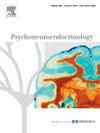在缺乏基础皮质酮升高的情况下,产后缺乏逆境会增加不良护理
IF 3.4
2区 医学
Q2 ENDOCRINOLOGY & METABOLISM
引用次数: 0
摘要
暴露于环境逆境(包括资源稀缺)会干扰孕产妇行为,从而损害孕产妇护理,增加虐待和虐待等不良护理行为。在大鼠中,暴露于资源稀缺会破坏母婴互动,并导致不良的幼崽导向的母性行为。这些母亲行为的变化被认为是由于下丘脑-垂体-肾上腺轴(HPA)的过度活跃,该轴介导应激反应。因此,hpa轴功能的上调足以驱动啮齿动物母性行为的变化。基于这些数据,我们假设匮乏逆境诱导的母性行为变化与大鼠应激激素皮质酮(CORT)基础水平升高有关。为了验证这一点,我们采用了匮乏-逆境模式,在产后2-9天(PD)创造了一个贫困的笼子环境,并检查了对母鼠自然行为和基础粪便粪便CORT水平(PD 3, PD 5, PD 7)或基础和应激诱导的血清CORT水平(PD 9)的影响。令人惊讶的是,暴露于匮乏逆境中的大鼠表现出不利的幼崽导向行为(例如,踩踏,拖拽,推挤),但在评估的任何时间点上,基础或应激诱导的CORT水平均未升高。这些研究结果表明,稀缺逆境可以以与cort无关的方式增加不良护理。因此,在匮乏-逆境范式中,基础CORT水平的增加并不是诱导异常母性行为的必要条件。本文章由计算机程序翻译,如有差异,请以英文原文为准。
Postpartum scarcity-adversity increases adverse caregiving in the absence of basal corticosterone elevation
Maternal behavior is disturbed by exposure to environmental adversity, including resource scarcity, which can impair maternal care and increase adverse caregiving behaviors like abuse and maltreatment. In rats, exposure to resource scarcity disrupts mother-infant interactions and results in adverse pup-directed maternal behaviors. These changes in maternal behavior are thought to be due to hyperactivity within the hypothalamic-pituitary-adrenal (HPA)-axis, which mediates the stress response. In accordance, upregulation of HPA-axis function is sufficient to drive changes in maternal behavior in rodents. Based on these data, we hypothesized that scarcity-adversity induced changes in maternal behavior would be associated with HPA-axis hyperactivity, as indexed by elevated basal levels of the stress hormone corticosterone (CORT) in rat dams. To test this, we employed a scarcity-adversity paradigm based on creating an impoverished cage environment during postpartum days (PD) 2–9 and examined effects on naturalistic maternal behaviors and basal fecal boli CORT levels (PD 3, PD 5, PD 7) or basal and stress-induced serum CORT levels (PD 9). Surprisingly, rat dams exposed to scarcity-adversity exhibited increases in adverse pup-directed behaviors (e.g., stepping, dragging, shoving) but no elevations in basal or stress-induced CORT levels at any of the time-points assessed. These findings suggest that scarcity-adversity can increase adverse caregiving in a CORT-independent manner. Thus, increases in basal CORT levels are not necessary to induce aberrant maternal behavior in the scarcity-adversity paradigm.
求助全文
通过发布文献求助,成功后即可免费获取论文全文。
去求助
来源期刊

Psychoneuroendocrinology
医学-精神病学
CiteScore
7.40
自引率
8.10%
发文量
268
审稿时长
66 days
期刊介绍:
Psychoneuroendocrinology publishes papers dealing with the interrelated disciplines of psychology, neurobiology, endocrinology, immunology, neurology, and psychiatry, with an emphasis on multidisciplinary studies aiming at integrating these disciplines in terms of either basic research or clinical implications. One of the main goals is to understand how a variety of psychobiological factors interact in the expression of the stress response as it relates to the development and/or maintenance of neuropsychiatric illnesses.
 求助内容:
求助内容: 应助结果提醒方式:
应助结果提醒方式:


